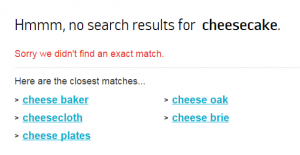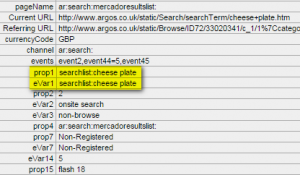The Search Term: Lister reports capture search terms entered by customers on the lister page load, not when it’s entered into the search box. Therefore, if a search term redirects to a page other than a search lister, such as a supplier shop or category lister, the term isn’t captured.
Another thing to note is that some promotional content links to search listers, and the search terms are captured in this report even though the customer didn’t physically enter anything into the search box. These terms are usually promotionally led, such as ‘shop for great offers on homewares’ or ‘this weeks new 7 day deals’ and so are easy to distinguish from real customer searches.
There is a prop and an eVar version of this report. See below for more detail on each;
Search Term: Lister (prop)
Reports & Analytics Location: Navigation → Search → Search Term: Lister (prop) Reports → Search Term: Lister (prop)
Search Term: Lister (prop) gives a count of how many times a particular search term was captured. Use this report to answer questions such as ‘what were the most popular search terms last week’ or ‘how many searches for ‘curtains’ did we have this week?’. You would also use this report to find terms resulting in no matches and no results, which are prefixed with ‘nomatch:’ and ‘noresults:’ respectively.
Metrics you can use with the Search Term: Lister (prop) report;
- Instances
Search Term: Lister (eVar)
Reports & Analytics Location: Navigation → Search → Search Term: Lister (eVar) Reports → Search Term: Lister (eVar)
Search Term: Lister (eVar) allows you to attribute conversion metrics such as revenue and orders to search terms, including terms generating no results or no match. Use this report to answer questions such as ‘what was the conversion rate for the term ‘blue sofa’?’ or ‘how many orders were generated from the term ‘curtains’ this week?’.
Metrics you can use with the Search Term: Lister (eVar) report;
- Conversion
- Any revenue metric (prefixed ‘Revenue:’)
- Any orders metric (prefixed ‘Orders:’)
- Any units metric (prefixed ‘Units:’)
- Average Order Value (AOV)
Note: This is an eVar report, and is based on a last-click wins model. This means that the last value captured before an order is placed is credited with the order and all associated metrics such as revenue and conversion.
For example if you were looking at the revenue figure attributed to the search term ‘blue sofa’, this value is all revenue taken in visits where this was the last Search Term: Lister value captured before an order was placed. So if a customer searched ‘blue sofa’ and then purchased a Dyson Vacuum Cleaner and a paddling pool without making another search, the revenue from both products would be assigned to the ‘blue sofa’ search term. See more about how eVars attribute sales here.
FAQ’s
Q: How do I know if a particular search term will be captured in this report?
A: There are three ways you can tell if the term will be captured in this report;
- Check the page name of the page you land on after entering the search term. If it is one of the below then you have landed on a search lister, no results or no match page and the term is captured in this report.
- ar:search:mercadoresultslist:
- ar:search:noresults:
- ar:search:nomatch:
- If you land on a lister and you can see the phrase “You searched for “search term” (x results found)” and the term remains in the search box then it has been captured. All terms that result in a no match or no results page are captured.


- Use a debugging tool to check whether eVar1 or prop1 have been populated on the page you have landed on after entering the term.

Q: In which scenarios will the search term not be captured in this report?
- If you are redirected to a Supplier shop (for example when you search ‘Lego’ or ‘iPad’).
- If you are redirected to a category lister (for example when searching ‘Mattress’). You will know you are on a category lister if you see the category breadcrumb instead of the “You searched for “search term” (x results found)” phrase that you would see on a search lister.

Q: What is “(Low Traffic)” in the Search Term: Lister reports?
A: We are only able to capture 500k unique values in any report. In this example, when we have captured more than 500k unique search terms, the terms with the lowest volumes are bucketed under ‘(Low Traffic)’. In other words, all the lowest volume search terms are contained within (Low Traffic) in order to bring the number of unique search terms down to 500k.
Q: What is ‘noresults:’ in the Search Term: Lister reports?
A: There is a defect where in some instances a search term results in a noresults page but the search term isn’t captured, if this is the case you will see ‘Hmmm no results for .’ on the page. These terms are bucketed into ‘noresults:’ and we estimate around 5% of noresults instances are not being captured. This is not likely to be fixed due to the analytics refactor and new search UI that is being developed.
Q: Can I filter search terms to those relevant to my category?
A: Currently search terms are not classified to product categories due to this being a manual and labour-intensive process to set-up and maintain.
